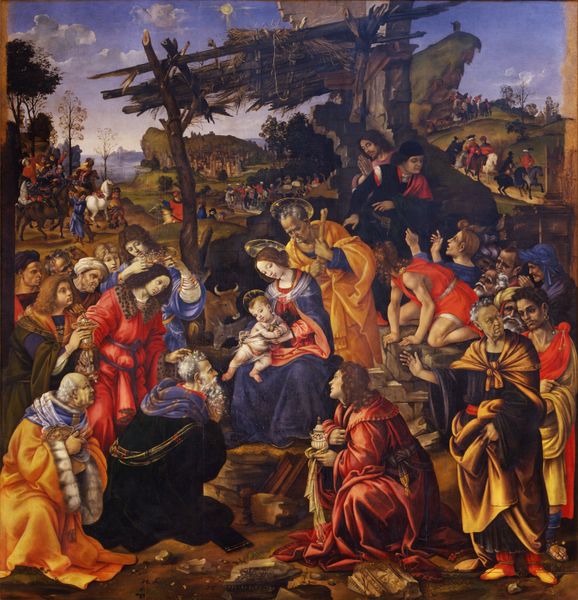
painting, oil-paint
#
venetian-painting
#
painting
#
oil-paint
#
figuration
#
oil painting
#
mythology
#
painting painterly
#
history-painting
#
italian-renaissance
Copyright: Public domain
Curator: Let's spend some time contemplating Jacopo Bassano's "Adoration of the Shepherds," created around 1545. It exemplifies the Venetian painting style of the time. Editor: My immediate reaction is to the grounded, almost rustic feel despite its grand subject matter. Look at the coarse fabrics, the lived-in expressions; you can almost smell the straw. Curator: That's typical of Bassano's approach. He often placed religious scenes in pastoral settings, elevating the everyday life of peasants to biblical significance, reflecting perhaps the growing merchant class's appreciation for the rural life that sustained their prosperity. Editor: Right. And he doesn’t shy away from showing labor. The shepherds aren't just reverently kneeling; they look like they’ve come directly from the fields, tools in hand. It challenges the idea of high art by connecting it to labor, materiality and necessity. The ox near the manger seems painted with as much care as any of the figures, wouldn't you agree? Curator: Absolutely. Bassano was very skilled at animal painting. One cannot separate that talent from its significance: placing farm animals at center stage brings a moral dimension of compassion for creation that might reflect emergent trends of natural philosophy or the Franciscan value system prominent during his era. Editor: And speaking of creation, you can see how he builds up the textures using oil paint; almost tactile. Think about the cost of pigments, the grinding, the mixing – this was laborious work! It's all there on the canvas. Curator: Exactly. And beyond that, think about the socio-economic factors: How did Bassano obtain his commissions? Who had access to art, and how did Bassano's style cater to a certain viewership and, thus, secure his patrons? These historical queries help us uncover the painting's value and function in society at that time. Editor: Looking closer at how he crafted this with paint, and thinking about how raw those materials are, I realize that it really bridges heaven and earth in its making. Curator: So, we have seen Bassano blending social observation with deep religious sentiment and superb use of oil paints. What a contribution to the narrative painting tradition! Editor: Yes, this is an honest painting that prompts us to consider materials and history within and beyond the artwork itself.
Comments
No comments
Be the first to comment and join the conversation on the ultimate creative platform.













